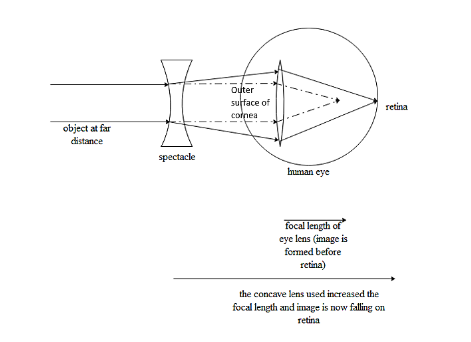
When the light rays enter the eye, most of the refraction occurs at the
A. crystalline lens
B. outer surface of the cornea
C. iris
D. pupil
Answer
526.8k+ views
Hint: Cornea is defined as the transparent spherical portion of the eye which covers the pupil and the iris. The rays from the object enter through this transparent cornea when an object comes in front of the eye. This refraction happens at the outer surface.
Complete answer:
First of all let us take a look at the phenomenon of refraction. It is the phenomenon which is producing the image in front of the eye and also in front of the cameras and other systems containing lenses.
As the transition from the air into the cornea is taking place firstly at the surface of the cornea, most of the refraction is occurring in this area. Here is the largest variation in the refractive index for refraction the light is experiencing. Only the 20 percent of the refraction is occurring in the inner crystalline lens and almost 80 percent of the refraction is happening in the cornea. As we all know that the inner lens is the smaller area for the refraction, it is acting as the total source of the ability to include the focus of the eye for making close objects visible. In the case of a normal eye, the inner lens can vary the total focal length of the eye to a great extent.

So, the correct answer is “Option B”.
Note:
There are so many eye defects which are seen in common that one is called for the refractive errors which can be corrected by the usage of compensating lenses. They may include myopia or hypermetropia. Hypermetropia is the long sightedness which is corrected using a convex lens and myopia is the near sightedness which is compensated by the use of a concave lens.
Complete answer:
First of all let us take a look at the phenomenon of refraction. It is the phenomenon which is producing the image in front of the eye and also in front of the cameras and other systems containing lenses.
As the transition from the air into the cornea is taking place firstly at the surface of the cornea, most of the refraction is occurring in this area. Here is the largest variation in the refractive index for refraction the light is experiencing. Only the 20 percent of the refraction is occurring in the inner crystalline lens and almost 80 percent of the refraction is happening in the cornea. As we all know that the inner lens is the smaller area for the refraction, it is acting as the total source of the ability to include the focus of the eye for making close objects visible. In the case of a normal eye, the inner lens can vary the total focal length of the eye to a great extent.

So, the correct answer is “Option B”.
Note:
There are so many eye defects which are seen in common that one is called for the refractive errors which can be corrected by the usage of compensating lenses. They may include myopia or hypermetropia. Hypermetropia is the long sightedness which is corrected using a convex lens and myopia is the near sightedness which is compensated by the use of a concave lens.
Recently Updated Pages
Physics and Measurement Mock Test 2025 – Practice Questions & Answers

NCERT Solutions For Class 5 English Marigold - The Little Bully

NCERT Solutions For Class 12 Maths Three Dimensional Geometry Exercise 11.1

NCERT Solutions For Class 11 English Woven Words (Poem) - Ajamil And The Tigers

NCERT Solutions For Class 6 Hindi Durva - Bhaaloo

NCERT Solutions For Class 12 Physics In Hindi - Wave Optics

Trending doubts
Which are the Top 10 Largest Countries of the World?

Differentiate between homogeneous and heterogeneous class 12 chemistry CBSE

Why is the cell called the structural and functional class 12 biology CBSE

a Tabulate the differences in the characteristics of class 12 chemistry CBSE

Who discovered the cell and how class 12 biology CBSE

Draw a labelled sketch of the human eye class 12 physics CBSE




